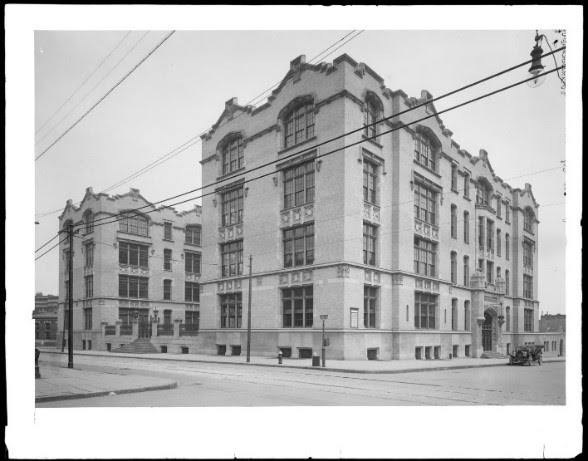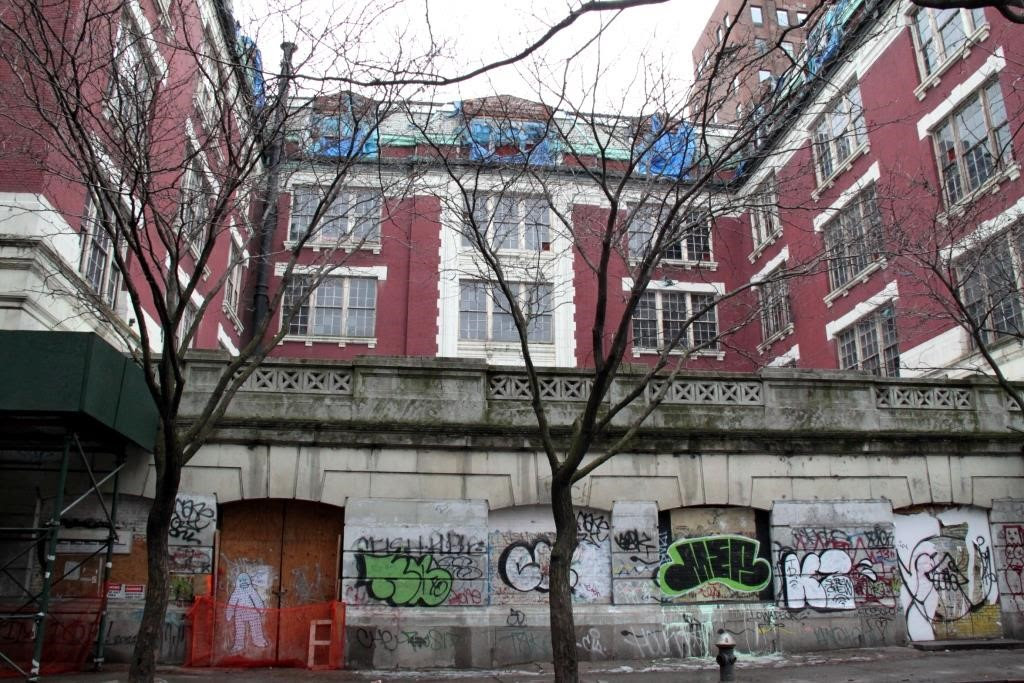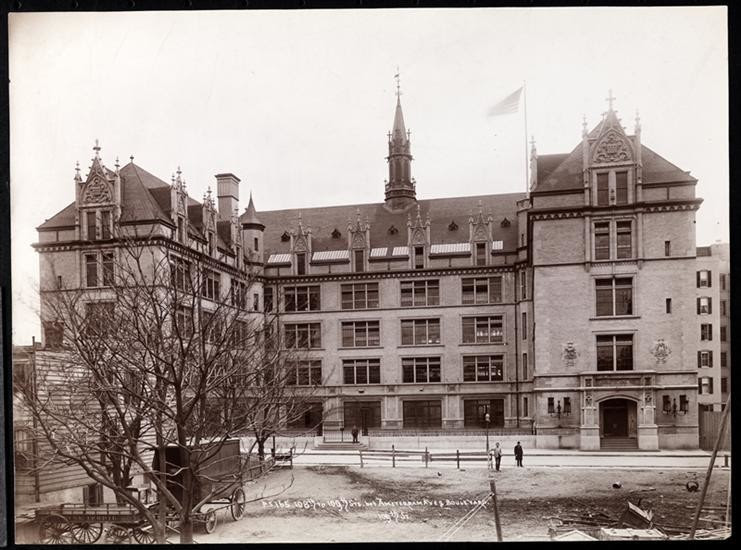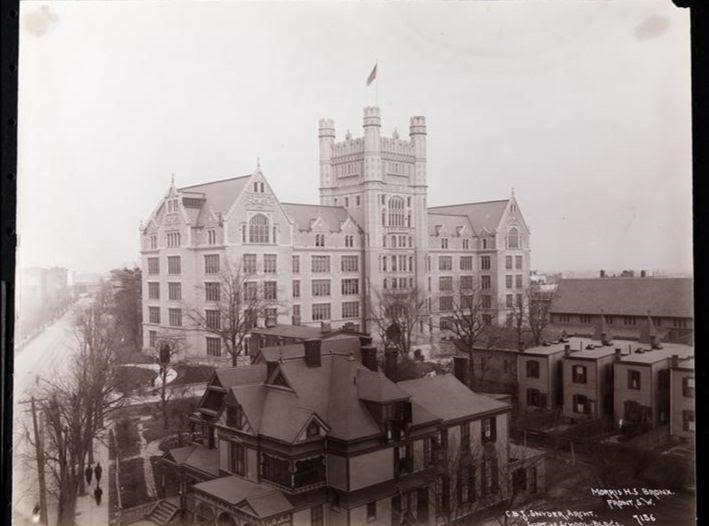Monday, January 17, 2022 – LOOK AROUND AND ADMIRE THOSE GRAND SCHOOL BUILDINGS


MONDAY, JANUARY 17, 2022
574th Issue
C.B.J. SNYDER
ARCHITECT OF OUR
GREAT NEW YORK CITY
SCHOOL BUILDINGS
STEPHEN BLANK
Recently we wrote about The New York Parental School and its architect C.B.J. Snyder. Here is much more on the man who designed glorious school buildings.

Think of someone who had an enormous positive impact on the City, who was a City employee, a prolific builder who never got rich and whose name is scarcely known today. I give you Charles B. J. Synder.
Who was he? A builder of schools. At the turn of the 20th century, he designed and supervised the construction of 400 public schools in New York. Not only many schools, but attractive, safe and healthy schools. In his 1902 book “The Battle With the Slum,” the social reformer Jacob Riis wrote of Snyder: “Mr. Snyder builds New York’s schools, and he does that which no other architect before his time ever did or tried; he ‘builds them beautiful.’ In him New York has one of those rare men who open windows for the soul of their time. Literally, he found barracks where he is leaving palaces to the people.” A public school that “opens the windows of the soul” – not bad. So, what’s the story here?

Public funds for education became available after 1795, and in Manhattan a Free School Society was formed to disperse the state money. Later, a parallel Catholic parochial school system was constructed. A compulsory attendance law for the primary grades was enacted in 1874 but the city school system was soon overloaded by new immigration. Universal school attendance was never realized.
For many children, life was tough. In the winter of 1892, Riis visited eleven of the city’s sixteen riverside dumps to investigate the enforcement of two public health laws: one required that old rags be washed before resale, and the other forbade rag pickers from living in the dumps. He learned that neither law was enforced. Riis saw women and children working and living in the dumps. He wrote: “I found boys who ought to have been at school, picking bones and sorting rags. They said that they slept there, and as the men did, why should they not? It was their home. They were children of the dump, literally.”
For those who went to school, New York’s public schools were widely viewed as wretched. A Harper’s article (“New York Common Schools”) published in the winter of 1894-95 quoted Dr Rice, New York City Commissioner of Education: “The typical New York public school is a hard, unsympathetic, mechanical-drudgery school – a school in which the light of science has not entered.” The article describes how the schools “crowd little children into ill-ventilated rooms, and keep them for hours at work by the light of flaring gas…”
School construction? Horrible. Christopher Gray writes that “From 1884 to 1891, the architect for the Board of Education had been George Debevoise, whose work was described by the Real Estate Record and Guide in 1893 as ’a civic disgrace — warehouses have greater artistic value.’ Debevoise resigned suddenly amid suggestions that he had schemed with contractors to substitute cheaper materials in school projects — although criminal charges were never filed.”
In 1898, William H. Maxwell was appointed superintendent of the newly consolidated New York City school system. An Irish immigrant himself, Maxwell was a visionary advocate of improving education for the immigrant children then flooding into New York’s schools. Maxwell first fought and defeated the old corrupt system that permitted political bosses to hire teachers. He then sought better-trained, professional teachers and selected them based on their qualifications.
The flood of new New Yorkers intensified. In 1909, the U.S. Immigration Commission reported that over 70% of New York City students were children of immigrants. Between 1900 and the beginning of World War I in 1914, New York schools experienced a 60% increase in enrollment. Most of these new students were Russian Jews and Italians, either immigrants themselves or the children of immigrants. Moreover, the cultural backgrounds and languages of these “new” immigrants were quite different from those of the English, Germans, and Irish who had dominated immigration to America before 1900.
Overcrowding plagued New York schools. Many schools held double sessions. A single classroom with one teacher often held 60 and occasionally up to 150 children. In the primary grades, pupils frequently sat three to a seat. Many immigrant children had only three hours of instruction a day. During some years, as many as 30,000 new students, mostly immigrants, were simply turned away.

But a new light was dawning. In 1891, with the firing of Debevoise, the Board of Education had turned to Charlies Snyder, a slight man, born in Stillwater, north of Albany, a descendant of Dutch settlers in Saratoga Springs. He was 31 years old, an architect and mechanical engineer, had studied at Cooper Union and worked with the obscure New York architect William E. Bishop. Gray says that it’s not clear how he got the job, “but it must have had something to do with the banker Robert Maclay, who served as head of the school board’s building committee — Snyder gave his son Robert, born about 1894, the middle name Maclay.” Snyder would serve as Superintendent of School Buildings until 1923.

For the next three decades, Snyder presided over the greatest expansion of elementary, middle, and high schools in the five boroughs in the nation’s history. It was not uncommon for him to open more schools in a single year than existed in most other American cities. His buildings were big enough to hold the waves of immigrants flooding into the city, to have indoor play areas for the kids and auditoriums for the community, and light and air, the values of an age made real in brick, mortar and steel. “He found barracks, where he is leaving palaces to the people.”
Snyder’s schools are widely praised for their quality, longevity, and beauty. He worked in many styles – Beaux Arts, Flemish Renaissance, Italian palazzo, Collegiate Gothic and Renaissance Revival – but all embodied his commitment to health and safety issues, improving fire protection, ventilation, lighting, and classroom size. All schools were to be built of fireproof materials, capable of being emptied within three minutes. Snyder’s schools included auditoriums with projection rooms and organs, space for public art, laboratories, vocational training facilities, gymnasiums, swimming pools and roof playgrounds. The buildings were designed also to accommodate new after-school activities like recreation classes and evening lectures. Light was key. He pushed an “H” design, with enclosed outdoor play areas. In these buildings, 60% the exteriors were made up of windows, double what had been the standard; many of these were 10 feet high.
1910 Eastern District Brooklyn High School P.S. 64 sitting dormant in 2013, courtesy of GVSHP
1897 Public School 165 The first school to make use of Snyder’s H-plan Snyder’s Morris High School in the Bronx, shot by Jacob Riis in 1903. (MCNY).
Today, thirteen of his schools and five of his additions have been landmarked. Two-hundred and eighty of the buildings remain standing and 235 of these are still public schools (the rest have been converted to everything from condos to health facilities, artist housing, halfway homes and shelters). Some have been divided up into three or four schools; some are the subject of fierce legal battles as they crumble in place.
Today’s problem is clear. Half the city’s 1,100 main school buildings are already more than 50 years old, and nearly 40% were built before 1930. Many lack gymnasiums, air-conditioning and cannot accommodate computers and other modern technology. Many great neo-Gothic and Renaissance-style schools were built from 1891 to 1923 during Charles B. J. Snyder’s tenure as Superintendent of School Buildings. ”Some of these schools are almost like a church, quite elegant, handsome, massive and distinctive buildings that are likely to lead to lofty thoughts,” said Timothy D. Lynch, who has worked with both the construction authority and preservationists in rehabilitating old schools. ”Do you need 30 landmarked Snyder schools? Probably not. Is one better than the other? Probably not.”
These schools are expensive to rehabilitate — sometimes it costs as much as a new school. The City Comptroller estimates that it would take more than $9 billion to modernize 455 of the schools built before 1950. Preservationists and residents say they should not be destroyed. In many instances, they are the last architectural jewels in their neighborhoods. And over the decades, they have remained productive, providing classrooms for generations and acting as town halls.
Interesting how the work of this little known man – schoolhouses! – continues to roil our City, not because the buildings are so poorly built and unhealthy but because they added so much value to our communities.
Thanks for reading.
Stephen Blank
RIHS
January 12, 2022
MONDAY PHOTO OF THE DAY
Send your answer to:
rooseveltislandhistory@gmail.com

WEEKEND PHOTO OF THE DAY
SUPERMAN LUNCHBOX
From Jay Jacobson:Used at PS 87. Carried only peanut butter and jelly sandwiches. Our mother filled our lunchboxes with whatever was in the refrigerator and was on the cusp of spoiling. My brother hated four out of five lunches each week. He told mother that he wanted only PBJ because they were easier to trade with other kids. He never traded. Ate the PBJ from third grade through 8th grade. Probably had a few of the lunchboxes. They would last only year or two. Then the latches broke.
Alexis Villefane, Laura Hussey and Gloria Herman remember the 1950’s school-lunch box

Stephen Blank
Sources
https://www.britannica.com/place/New-York-City/Education
https://www.crf-usa.org/bill-of-rights-in-action/bria-8-2-a-educating-european-immigrant-children-b
https://www.loc.gov/exhibits /jacob-riis/riis-and-reform.htmlefore-world-war-i
https://www.nytimes.com/2008/10/18/nyregion/18about.html https://www.6sqft.com/going-back-to-school-with-c-b-j-snyder-a-look-at-the-architects-educational-design/Thanks to Bobbie Slonevsky for her dedication to Blackwell’s Almanac and the RIHSThanks to Deborah Dorff for maintaining our website
Edited by Melanie Colter and Deborah Dorff
FUNDING PROVIDED BY ROOSEVELT ISLAND OPERATING CORPORATION PUBLIC PURPOSE GRANTS
CITY COUNCIL REPRESENTATIVE BEN KALLOS DISCRETIONARY FUNDING THRU DYCD
FUNDING PROVIDED BY ROOSEVELT ISLAND OPERATING CORPORATION PUBLIC PURPOSE GRANTS CITY COUNCIL REPRESENTATIVE BEN KALLOS DISCRETIONARY FUNDING THRU DYCD


Copyright © 2022 Roosevelt Island Historical Society, All rights reserved.Our mailing address is:
rooseveltislandhistory@gmail.com





Leave a comment